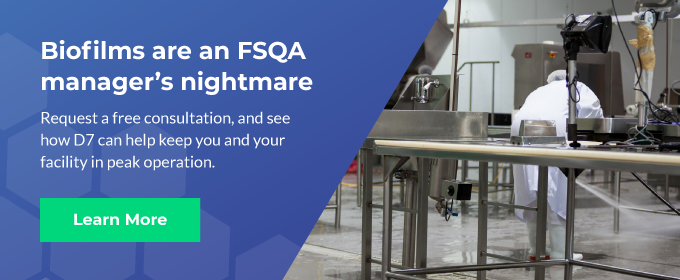.jpg?width=2119&name=GettyImages-1131834506%20(1).jpg)
Whether it’s protecting workers from COVID-19 or consumers from foodborne pathogens, preventing contamination in food production plants is critical. Plant closures due to outbreaks can be damaging to brands, even if no consumers are directly affected. Taking the necessary steps to prevent an outbreak of any kind from occurring will help protect employees, consumers, and brands.
One of the challenges related to preventing contamination is that it can come from multiple sources. Food processing plants already have measures in place to prevent the spread of bacteria, viruses, and mold to food or equipment during the production process. However, the spread of infection from worker to worker is a new challenge that the industry is quickly learning to address. Following certain protocols and regularly sanitizing your facility can help prevent multiple types of contamination.
1. Entryway Sanitation
As employees and equipment enter a facility or travel between zones, they can bring contaminants with them. Set up sanitation stations at entryways, and provide soap and water, hand sanitizer, and PPE for employees to use as soon as they enter the facility.
Use timed foamers to apply sanitizer to shoes and equipment wheels. Periodically apply sanitizing pellets to the floor to reduce the spread of pathogens between zones. Require all employees to sanitize their hands and shoes every time they enter the facility or a new zone.
2. Control Points
According to the FDA, control points are, “Any step at which biological, chemical, or physical factors can be controlled.” Identify these points in your facility when conducting a hazard analysis, and take the necessary steps for preventing contamination.
Examples of control points in a food processing facility include using magnets to test products for metal contaminants, chilling food to a specific temperature, and testing surfaces for pathogen levels. Because every facility is unique, there is no one-size-fits-all list of control points. This is why a hazard analysis must be done in each location. The FDA provides an example of a decision tree to help you identify the control points in your facility.
3. Deep Cleaning
Deep cleaning, which goes beyond the steps taken during daily sanitation, should be done periodically or after a contamination event. During a deep clean, surfaces and items that are more difficult to reach are cleaned and sanitized. This might include ceilings and walls, drains, behind equipment, and inside equipment that must be partially or fully disassembled. Deep cleaning should not only be performed after an outbreak, but also used as a preventive measure and to help prevent the formation of biofilms.
4. Contact Times for Sanitizers
Whether they are being used for deep cleaning, daily sanitation, or between work shifts, sanitizers must be applied correctly in order to be effective.This includes:
-
- Selecting products that are approved for the specific use case
- Cleaning the surface of all visible soils before applying the sanitizer
- Ensuring the product is properly mixed or diluted, if necessary
- Applying the sanitizer to cover all surfaces
- Ensuring the sanitizer stays on surfaces for the minimum recommended contact time
- Thoroughly rinsing, if required
5. Employee Training
Instruct employees that they should not come to work if they feel sick or have any symptoms related to COVID-19. Display CDC-approved printable signs to inform employees about the symptoms and what they can do to prevent the spread of the virus. Provide training on personal hygiene and proper handwashing techniques. Require the use of appropriate PPE, and make sure employees know how to safely put on and remove PPE to avoid cross-contamination.
Train each employee on the cleaning and sanitizing protocols you require, and ensure that they understand how to mix and apply sanitizer. Create a record-keeping system that employees are required to use so you have a clear history of when sanitizing procedures were done, who did the work, and what products they used.
Prevention Is Worth the Investment
Preventing contamination and the spread of disease is a much better approach than dealing with an outbreak, especially when it comes to the health of individual workers. Taking proactive steps to protect employees, consumers, and your brand is a smart investment of time and resources. Remember that the consequences of an outbreak can be much more costly.
If you’d like to learn more about how you can protect both employees and consumers, ask us about our public safety applications.


